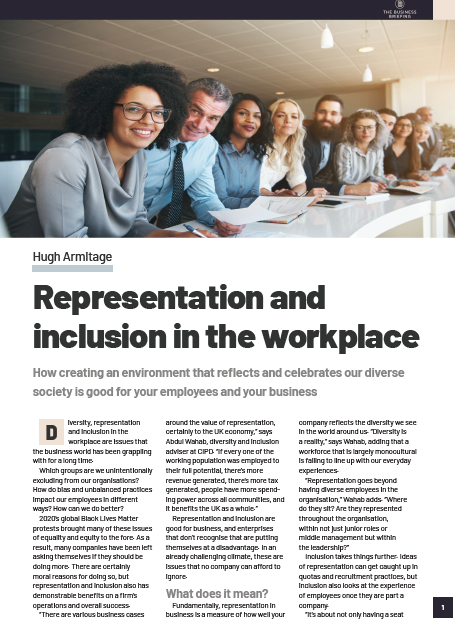What is design thinking and why do diverse workforces do it better?
From 'innovation revenue' to first mover advantage, design thinking has a lot to offer


Design thinking is a long established principle in business and beyond. Organisations that take a design thinking approach are focused on end users – existing or potential – and develop their products or services with an end user perspective right from the outset. Organisations with a diverse workforce have a much better chance of taking a design thinking approach to its full potential.
Why does design thinking matter to tech firms?
Tech firms, by their very nature, are innovators. No tech firm can thrive by standing still. Existing products and services must be updated at regular intervals, new products and services must be brought onto the market.
According to Ileana Stigliani, an associate professor of design and innovation at Imperial College Business School who teaches part of the Digital Transformation Strategy Executive Education programme, design thinking is the key to outperforming competition. “Nowadays, the success of tech companies depends on their ability to use technology to address unmet users’ needs,” she explains.
In the Executive Education Programme on Digital Transformation at Imperial, this approach is called “using design thinking to lead from the front end” she says.
“The design of successful digital solutions starts with a deep understanding of users’ needs and behaviours – the front end – rather than being pushed to the market from the back end of the organisation.”
Why a diverse workforce is crucial
To get the best from taking a design thinking approach firms should have a diverse workforce. If a firm is looking at product or service development from the point of view of its end-users, it needs to be able to think like them, analyse, plan and be a critical friend to itself like them. As Perrine Farque, a diversity and inclusion speaker and consultant tells IT Pro: “Diverse teams create more innovative solutions, and innovations are what tech companies need to survive”. She points to a 2018 study by BCG that found that companies with above-average diversity have greater “innovation revenue”, meaning they produce a greater proportion of revenue from new products and services than organisations that are less diverse.
Stigliani adds that “a design thinking team should be a multi-disciplinary team consisting of a mix of specialisations, personalities, cultural backgrounds, and so on, where team members can cover each other’s blind spots, minimise biases, challenge assumptions and avoid groupthink”.
Get the ITPro daily newsletter
Sign up today and you will receive a free copy of our Future Focus 2025 report - the leading guidance on AI, cybersecurity and other IT challenges as per 700+ senior executives
Innovation and design thinking go hand in hand
Tech firms that innovate and find new opportunities in the market that have not been spotted before can reap great rewards. Think of the first tablet computer, something that many of us now take for granted but was a complete novelty when it first appeared.
Firms that don’t take a design thinking approach can find themselves just working to please the mainstream. Stigliani points out that this results in missed opportunities, whereas design thinking really helps with innovation. Working just to meet the needs of mainstream users, she says, results in “overlooking areas where the real opportunities for innovation and business growth lie – at the margins of markets. Engaging with extreme users, whose behaviours and needs deviate from the norm, is not only good for business, as they represent under-served market segments, but for creativity too – rarely do average users inspire ground-breaking innovations.”
RELATED RESOURCE

Representation and inclusion in the workplace
Sample our exclusive Business Briefing content.
The flip side of failing to take a design thinking approach is potentially dark for tech firms. According to Stigliani, the most serious consequence of not taking a design thinking approach to product innovation is extinction. “Being able to innovate is a matter of survival,” she explains. “If tech companies don’t disrupt themselves by transforming the way they approach and solve problems, they will be disrupted.”
Take steps in the right direction
Even if the market leaders understand and use the principles, a design thinking approach taken without a diverse workforce might not come easily to all tech firms. Stigliani suggests firms should ask themselves three fundamental questions: “Are we willing to take risks and tackle problems the solutions of which cannot be found in past experiences and cannot be proven by data? Are we open to experimenting and using possible failures as learning opportunities? Do we value different perspectives and inclusive design?” Answering yes to these questions is, she said, “the first step towards becoming design-driven”.
Farque puts even more emphasis on increasing diversity, which is necessary for design thinking to realise its potential, saying that firms should set diversity goals and tie these to monetary compensations. “Goals drive behaviour [and] monetary goals drive behaviour faster,” she says. “If you are committed to diversity and inclusion, you must set goals for your leadership team that are tied to monetary bonuses. Having worked with numerous tech organisations and had countless conversations on diversity and inclusion, I have witnessed that setting diversity goals that are financially rewarded is the only route to success.”

Sandra Vogel is a freelance journalist with decades of experience in long-form and explainer content, research papers, case studies, white papers, blogs, books, and hardware reviews. She has contributed to ZDNet, national newspapers and many of the best known technology web sites.
At ITPro, Sandra has contributed articles on artificial intelligence (AI), measures that can be taken to cope with inflation, the telecoms industry, risk management, and C-suite strategies. In the past, Sandra also contributed handset reviews for ITPro and has written for the brand for more than 13 years in total.
-
 Westcon-Comstor and Vectra AI launch brace of new channel initiatives
Westcon-Comstor and Vectra AI launch brace of new channel initiativesNews Westcon-Comstor and Vectra AI have announced the launch of two new channel growth initiatives focused on the managed security service provider (MSSP) space and AWS Marketplace.
By Daniel Todd Published
-
 Third time lucky? Microsoft finally begins roll-out of controversial Recall feature
Third time lucky? Microsoft finally begins roll-out of controversial Recall featureNews The Windows Recall feature has been plagued by setbacks and backlash from security professionals
By Emma Woollacott Published
-
 Imposter syndrome is pushing women out of tech
Imposter syndrome is pushing women out of techNews Men have dominated the tech space, though some evidence suggests that it's beginning to change
By George Fitzmaurice Published
-
 DEI rollbacks could exacerbate tech talent shortages – nearly half of recruitment leaders worry diversity cuts will impact their company’s appeal and employee retention
DEI rollbacks could exacerbate tech talent shortages – nearly half of recruitment leaders worry diversity cuts will impact their company’s appeal and employee retentionNews Finding talent with AI skills has already become a major challenge for enterprises, but with some enterprises shelving DEI hiring practices, research suggests the situation could get worse.
By Emma Woollacott Published
-
 Women in tech think the industry has changed for the better, but there’s still more work to be done
Women in tech think the industry has changed for the better, but there’s still more work to be doneNews 84% of female tech leaders in the US believe the industry has changed for the better, but lingering issues still persist.
By Nicole Kobie Published
-
 Businesses know they have major skills deficits, but less than half plan on hiring more women
Businesses know they have major skills deficits, but less than half plan on hiring more womenNews Male IT leaders remain complacent about gender diversity despite widespread skills shortages
By Emma Woollacott Published
-
 Addressing the gender divide in the channel
Addressing the gender divide in the channelIndustry Insight Tackling a long-standing gender deficit could be a key differentiator for the channel amid challenging economic conditions
By Celine Cazali Published
-
 Female representation in UK cyber drops amid growing skills demand
Female representation in UK cyber drops amid growing skills demandNews While firms are accelerating efforts to recruit more women, an industry shortfall still remains
By Ross Kelly Published
-
 Little is being done to address the tech industry's racial hiring bias, report
Little is being done to address the tech industry's racial hiring bias, reportNews Non-white individuals are far less likely to be offered an interview compared to other applicant groups, research shows
By Ross Kelly Published
-
 Proudflare: Inside Cloudflare's pioneering DEI efforts
Proudflare: Inside Cloudflare's pioneering DEI effortsNews Cloudflare's initiative provides free services for at-risk advocacy groups
By Rory Bathgate Published